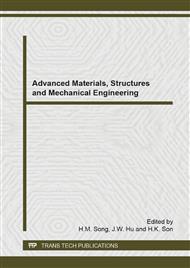p.415
p.419
p.423
p.427
p.432
p.436
p.440
p.445
p.451
Evaluation of Bamboo Particleboards Produced with Urea-Formaldheyde Resin
Abstract:
The bamboo waste can be an alternative material to sustain the crescent demand for particleboards, also bringing ecological benefits as reduction of the pressure for raw materials and landfill space demands. In this context, this research aimed to manufacture and determine some physical and mechanical properties of particleboards with bamboo waste particles (Dendrocalamus giganteus), obtained from different sources, bonded with four different percentages of urea–formaldehyde (UF) based resin (6%, 8%, 10% and 12% related to dry material of particles). Response variables investigated were: density; moisture content; thickness swelling in 2 and 24 hours; water absorption in 2 and 24 hours; internal adhesion (STpe); strength in tension parallel to faces (STpa); modulus of elasticity (MOE) and modulus of rupture (MOR). Results permitted to conclude that particleboards as mentioned showed good performance only in the physical properties requirements imposed by Brazilian Standard NBR 14810, but this was not observed to mechanical properties considered. New researches are needed in order to optimize the producing process parameters.
Info:
Periodical:
Pages:
432-435
Citation:
Online since:
September 2014
Keywords:
Price:
Сopyright:
© 2014 Trans Tech Publications Ltd. All Rights Reserved
Share:
Citation:


